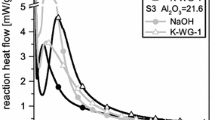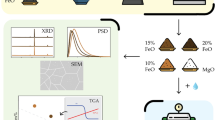Abstract
Hydration behavior of mechanically activated magnesia-ferriferous slag has been investigated by isothermal calorimetry. The slag is a waste of pyrometallurgical processing of Cu–Ni ores. Hydration activity of the slag is low in comparison to that of blast furnace slag. It has been shown that mechanical activation of the magnesia-ferriferous slag in CO2 atmosphere considerably increases its hydration activity. In the course of milling in planetary mill in CO2, the slag absorbs carbon dioxide molecules in the form of carbonate ions not only on the surface, but also in the bulk of the slag particles. This accelerates dissolution of the slag in water and the consequent formation of hydration reaction products. As a result, the slag is hardened at ambient temperature without addition of alkali agents or other chemical activators. Calorimetric measurements show that for the slag milled in CO2 the acceleration period comes without the induction period immediately following the initial exothermal peak. For the slag milled in air, the induction period lasts for about 20 days. Milling of the slag in CO2 results in higher intensity of the main heat evolution rate peak and larger cumulative hydration heat as compared to those for the slag milled in air. The compressive strength of the slag milled in CO2 is 12–14 MPa after the main hydration stage, whereas that of the slag milled in air is only about 1 MPa. This can be explained by the mechanically induced carbonization of the slag resulting in its higher reactivity and faster hydration relative to those for the slag milled in air.










Similar content being viewed by others
References
Piatak NM, Parsons MB, Seal RR. Characteristics and environmental aspects of slag: a review. Appl Geochem. 2015;57:236–66.
Shi C, Qian J. High performance cementing materials from industrial slags—a review. Resour Conserv Recycl. 2000;29:195–207.
Kumar S, Kumar R, Bandopadhyay A. Innovative methodologies for the utilisation of wastes from metallurgical and allied industries. Resour Conserv Recycl. 2006;48:301–14.
Davidovits J. Geopolymers—inorganic polymeric new materials. J Therm Anal. 1991;37:1633–56.
Provis JL, van Deventer JSJ, editors. Alkali-activated materials: state of the art report of RILEM TC 224-AAM. Dordrecht: RILEM/Springer; 2014.
Provis JL, Palomo A, Shi C. Advances in understanding alkali-activated materials. Cem Concr Res. 2015;78A:110–25.
Shi C, Krivenko PV, Roy DM. Alkali-activated cements and concretes. Abingdon: Taylor & Francis; 2006.
Brough AR, Atkinson A. Sodium silicate-based, alkali-activated slag mortars Part I. Strength, hydration and microstructure. Cem Concr Res. 2002;32:865–79.
Rosenqvist T. Principles of extractive metallurgy. 2nd ed. Trondheim: Tapir Academic Press; 2004.
Gurevich BI. Binders produced from technogenic raw materials of the Kola Peninsula. Apatity: Kola Science Center of RAS; 1996 (in Russian).
Heinicke G. Tribochemistry. Berlin: Akademie Verlag; 1984.
Avvakumov EG. Mechanical methods of activation of chemical processes. Novosibirsk: Nauka; 1986 (in Russian).
Boldyrev VV. Mechanochemistry and mechanical activation of solids. Russ Chem Rev. 2006;75:177–89.
Balaz P. Mechanochemistry in nanoscience and minerals engineering. Berlin: Springer; 2008.
Balaz P, Achimovicova M, Balaz M, Billik P, et al. Hallmarks of mechanochemistry: from nanoparticles to technology. Chem Soc Rev. 2013;42:7571–637.
Guo X, Xiang D, Duan G, Mou P. A review of mechanochemistry applications in waste management. Waste Manag. 2010;30:4–10.
Kumar R, Kumar S, Badjena S, Mehrotra SP. Hydration of mechanically activated granulated blast furnace slag. Metall Mater Trans B. 2005;36:873–83.
Kalinkin AM, Kumar S, Gurevich BI, Alex TC, Kalinkina EV, Tyukavkina VV, Kalinnikov VT, Kumar R. Geopolymerization behavior of Cu–Ni slag mechanically activated in air and in CO2 atmosphere. Int J Miner Process. 2012;112–113:101–6.
Alex TC, Kalinkin AM, Nath SK, Gurevich BI, Kalinkina EV, Tyukavkina VV, Kumar S. Utilization of zinc slag through geopolymerization: influence of milling atmosphere. Int J Miner Process. 2013;123:102–7.
Butyagin PY. Mechanical reactions of solids with gases. React Solids. 1986;1:345–59.
Khodakov GS. Sorption mechanochemistry of solid inorganic materials. Colloid J. 1994;56:113–28 (in Russian).
Kalinkina EV, Kalinkin AM, Forsling W, Makarov VN. Sorption of atmospheric CO2 and structural changes of Ca and Mg silicate minerals during grinding. I. Diopside. Int J Miner Process. 2001;61:273–88.
Kalinkin AM, Kalinkina EV, Politov AA, Makarov VN, Boldyrev VV. Mechanical interaction of Ca silicate and aluminosilicate minerals with CO2. J Mater Sci. 2004;39:5393–8.
Turianicová E, Obut A, Tuček L, Zorkovská A. Interaction of natural and thermally processed vermiculites with gaseous carbon dioxide during mechanical activation. Appl Clay Sci. 2014;88–89:86–91.
Turianicová E. CO2 utilization for mechanochemical carbonation of celestine. GeoSci Eng. 2015;61:20–3.
Yuan B, Yu QL, Brouwers HJH. Time-dependent characterization of Na2CO3 activated slag. Cem Concr Compos. 2017;84:188–97.
Erdogan ST, Koçak TÇ. Influence of slag fineness on the strength and heat evolution of multiple-clinker blended cements. Constr Build Mater. 2017;155:800–10.
Kani EN, Allahverdi A, Provis JL. Calorimetric study of geopolymer binders based on natural pozzolan. J Therm Anal Calorim. 2017;127:2181–90.
Han F, Zhang Z, Liu J, Yan P. Hydration kinetics of composite binder containing fly ash at different temperatures. J Therm Anal Calorim. 2016;124:1691–703.
Nocun-Wczelik W. Differential calorimetry as a tool in the studies of cement hydration kinetics with sulphate and nitrate solutions. J Therm Anal Calorim. 2017;130:249–59.
Sanderson RA, Gavin M, Cann GM, Provis JL. Comparison of calorimetric methods for the assessment of slag cement hydration. Adv Appl Ceram. 2017;116:186–92.
McClellan AL, Harnsberger HF. Cross-sectional areas of molecules adsorbed on solid surfaces. J Coll Int Sci. 1967;23:577–99.
Liu S, Wang L, Gao Y, Yu B, Tang W. Influence of fineness on hydration kinetics of supersulfated cement. Thermochim Acta. 2015;605:37–42.
Nakamoto K. Infrared and Raman spectra of inorganic and coordination compounds. Part A: theory and applications in inorganic chemistry. New York: Wiley; 1997.
Acknowledgements
The calorimetric measurements were performed at the Centre for Thermogravimetric and Calorimetric Research of the Research Park of St. Petersburg State University.
Author information
Authors and Affiliations
Corresponding author
Rights and permissions
About this article
Cite this article
Kalinkin, A.M., Gurevich, B.I., Myshenkov, M.S. et al. A calorimetric study of hydration of magnesia-ferriferous slag mechanically activated in air and in CO2 atmosphere. J Therm Anal Calorim 134, 165–171 (2018). https://doi.org/10.1007/s10973-018-7439-9
Received:
Accepted:
Published:
Issue Date:
DOI: https://doi.org/10.1007/s10973-018-7439-9




